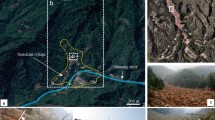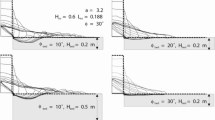Abstract
This paper presents a mass flow model that includes gravity force, material stresses, drag force and topography effects solving a set of hyperbolic partial differential equations by using a so-called depth-averaged technique. The model is non-linear and general enough to tackle various problems of interest for geophysics and environmental engineering, such as the dynamic evolution of flow-like avalanches, the dam break problem (involving only water flow) and the generation of tsunami waves by landslides. The model is based on a Eulerian fluid solver, using a second-order central scheme with a minmod-like limiter; is tested against a number of typical benchmark cases, including analytical solutions and experimental laboratory data; and also compared with other numerical codes. Through this model, we study a historical tsunamigenic event occurred in 1783 in Scilla, Italy, that resulted to be catastrophic with a toll exceeding 1500 fatalities. The landslide is reconstructed by a mixture debris flow, and results are compared with the observational data and other numerical simulations.












Similar content being viewed by others
References
Avolio MV, Lupiano V, Mazzanti P, Di Gregorio S (2009) A cellular automata model for flow-like landslides with numerical simulations of subaerial and subaqueous cases. EnviroInfo 1:131–140
Bozzano F, Chiocci F, Mazzanti P, Bosman A, Casalbore D, Giuliani R, Martino S, Prestininzi A, Mugnozza GS (2006) Subaerial and submarine characterization of the landslide responsible for the 1783 Scilla tsunami. In: Geophysical Research Abstracts, vol 8
Bozzano F, Lenti L, Martino S, Montagna A, Paciello A (2011) Earthquake triggering of landslides in highly jointed rock masses: reconstruction of the 1783 Scilla rock avalanche (Italy). Geomorphology 129(3–4):294–308
Brufau P, Vázquez-Cendón M, García-Navarro P (2002) A numerical model for the flooding and drying of irregular domains. Int J Numer Methods Fluids 39(3):247–275
Castro-Orgaz O, Hutter K, Giraldez JV, Hager WH (2015) Nonhydrostatic granular flow over 3-D terrain: new Boussinesq-type gravity waves? J Geophys Res Earth Surf 120(1):1–28
Catalano S, De Guidi G, Monaco C, Tortorici G, Tortorici L (2008) Active faulting and seismicity along the Siculo–Calabrian Rift Zone (southern Italy). Tectonophysics 453(1–4):177–192
Chen CL (1988) Generalized viscoplastic modeling of debris flow. J Hydraul Eng 114(3):237–258
Denlinger RP, Iverson RM (2004) Granular avalanches across irregular three-dimensional terrain: 1. Theory and computation. J Geophys Res Earth Surf 109(F1)
Faccanoni G, Mangeney A (2013) Exact solution for granular flows. Int J Numer Anal Methods Geomech 37(10):1408–1433
Fagherazzi S, Rasetarinera P, Hussaini MY, Furbish DJ (2004) Numerical solution of the dam-break problem with a discontinuous Galerkin method. J Hydraul Eng 130(6):532–539
Fennema RJ, Chaudhry MH (1990) Explicit methods for 2-d transient free surface flows. J Hydraul Eng 116(8):1013–1034
Fernández-Nieto ED, Bouchut F, Bresch D, Diaz MC, Mangeney A (2008) A new Savage–Hutter type model for submarine avalanches and generated tsunami. J Comput Phys 227(16):7720–7754
George DL, Iverson RM (2011) A two-phase debris-flow model that includes coupled evolution of volume fractions, granular dilatancy, and pore-fluid pressure. Italian J Eng Geol Environ 43:415–424
Gray J, Wieland M, Hutter K (1999) Gravity-driven free surface flow of granular avalanches over complex basal topography. Proc R Soc Lond A 455:1841–1874
Graziani L, Maramai A, Tinti S (2006) A revision of the 1783–1784 Calabrian (southern Italy) tsunamis. Nat Hazards Earth Syst Sci 6(6):1053–1060
Hungr O, McDougall S (2009) Two numerical models for landslide dynamic analysis. Comput Geosci 35(5):978–992
Iverson RM (1997) The physics of debris flows. Rev Geophys 35(3):245–296
Iverson RM, Denlinger RP (2001) Flow of variably fluidized granular masses across three-dimensional terrain: 1. Coulomb mixture theory. J Geophys Res Solid Earth 106(B1):537–552
Jiang GS, Tadmor E (1998) Nonoscillatory central schemes for multidimensional hyperbolic conservation laws. SIAM J Sci Comput 19(6):1892–1917
Kelfoun K, Druitt T (2005) Numerical modeling of the emplacement of Socompa rock avalanche, Chile. J Geophys Res Solid Earth 110(B12)
Kurganov A, Tadmor E (2000) New high-resolution central schemes for nonlinear conservation laws and convection–diffusion equations. J Comput Phys 160(1):241–282
La Rocca M, Montessori A, Prestininzi P, Succi S (2015) A multispeed discrete Boltzmann model for transcritical 2D shallow water flows. J Comput Phys 284:117–132
Lax PD (1954) Weak solutions of nonlinear hyperbolic equations and their numerical computation. Commun Pure Appl Math 7(1):159–193
Liang Q, Marche F (2009) Numerical resolution of well-balanced shallow water equations with complex source terms. Adv Water Resour 32(6):873–884
Liu W, He S, Li X (2016) A finite volume method for two-phase debris flow simulation that accounts for the pore-fluid pressure evolution. Environ Earth Sci 75(3):206
Louaked M, Hanich L (1998) TVD scheme for the shallow water equations. J Hydraul Res 36(3):363–378
Mangeney A, Vilotte JP, Bristeau MO, Perthame B, Bouchut F, Simeoni C, Yerneni S (2003) Numerical modeling of avalanches based on Saint Venant equations using a kinetic scheme. J Geophys Res Solid Earth 108(B11)
Mao J, Zhao L, Bai X, Guo B, Liu Z, Li T (2016) A novel well-balanced scheme for modeling of dam break flow in drying-wetting areas. Comput Fluids 136:324–330
Mazzanti P, Bozzano F (2011) Revisiting the February 6th 1783 Scilla (Calabria, Italy) landslide and tsunami by numerical simulation. Mar Geophys Res 32(1–2):273–286
Meng X, Wang Y (2016) Modelling and numerical simulation of two-phase debris flows. Acta Geotech 11(5):1027–1045
Meng X, Wang Y, Wang C, Fischer JT (2017) Modeling of unsaturated granular flows by a two-layer approach. Acta Geotech 12(3):677–701
Minasi G (1785) Continuazione ed appendice sopra i tremuoti descritti nella relazione colla data di Scilla de 30 settembre 1783, con altro che accadde in progresso. Messina, IT
Nessyahu H, Tadmor E (1990) Non-oscillatory central differencing for hyperbolic conservation laws. J Comput Phys 87(2):408–463
Ouyang C, He S, Xu Q, Luo Y, Zhang W (2013) A MacCormack-TVD finite difference method to simulate the mass flow in mountainous terrain with variable computational domain. Comput Geosci 52:1–10
Pastor M, Haddad B, Sorbino G, Cuomo S, Drempetic V (2009) A depth-integrated, coupled SPH model for flow-like landslides and related phenomena. Int J Numer Anal Methods Geomech 33(2):143–172
Pitman EB, Le L (2005) A two-fluid model for avalanche and debris flows. Philos Trans R Soc Lond A 363(1832):1573–1601
Porfido S, Esposito E, Violante C, Molisso F, Sacchi M, Spiga E (2011) Earthquakes-induced environmental effects in coastal area: some example in Calabria and Sicily (Southern Italy). Marine Research at CNR Dta
Pudasaini SP (2012) A general two-phase debris flow model. J Geophys Res Earth Surf 117(F3)
Rovida A, Camassi R, Gasperini P, Stucchi M (2011) The 2011 version of the parametric catalogue of Italian earthquakes. Milano, Bologna
Savage SB, Hutter K (1989) The motion of a finite mass of granular material down a rough incline. J Fluid Mech 199:177–215
Stoker JJ (1957) Water waves: the mathematical theory with applications. Interscience, New York 2:5
Tai YC, Noelle S, Gray J, Hutter K (2002) Shock-capturing and front-tracking methods for granular avalanches. J Comput Phys 175(1):269–301
Tinti S, Bortolucci E, Vannini C (1997) A block-based theoretical model suited to gravitational sliding. Nat Hazards 16(1):1–28
Xia X, Liang Q (2018) A new depth-averaged model for flow-like landslides over complex terrains with curvatures and steep slopes. Eng Geol 234:174–191
Zaniboni F, Armigliato A, Tinti S (2016) A numerical investigation of the 1783 landslide-induced catastrophic tsunami in Scilla, Italy. Nat Hazards 84(2):455–470
Acknowledgements
The authors thank Prof. Lanhao Zhao of the Hohai University, China, for handing over the EU CADAM experiment data.
Funding
This author Liang Wang thanks the China Scholarship Council (CSC) for the financial support from the cooperation agreement between the University of Bologna and the China Scholarship Council.
Author information
Authors and Affiliations
Corresponding author
Rights and permissions
About this article
Cite this article
Wang, L., Zaniboni, F., Tinti, S. et al. Reconstruction of the 1783 Scilla landslide, Italy: numerical investigations on the flow-like behaviour of landslides. Landslides 16, 1065–1076 (2019). https://doi.org/10.1007/s10346-019-01151-5
Received:
Accepted:
Published:
Issue Date:
DOI: https://doi.org/10.1007/s10346-019-01151-5




